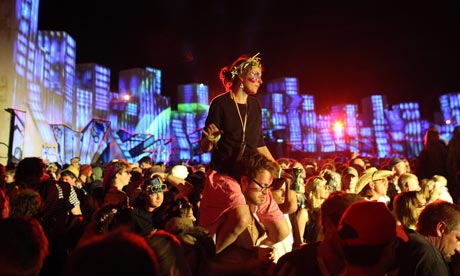There is a moment near the start of Julien Temple's new film about Glastonbury that shows the mass exodus of late-night revellers from the main stages towards a far corner of the festival. They wind their way along the muddy tracks like Christmas Island red crabs, like a column of army ants, floodlights falling on their waterproof hoods and their wild, bright faces: lit up, somehow, by the promise of the night before them. They are going to Shangri-La, the centre of out-of-hours hedonism that in 2009 evolved out of Lost Vagueness as the place to go when the music stops. Full of strange structures, souqs, sculptures, performance art and secret corners, its Blade Runner-style urban film set takes 1,500 crew and artists to construct. While Glastonbury lies fallow this year, Temple's film, Glastonbury After Hours, which will be broadcast a week or two ahead of when Glastonbury is usually held, feels a little like a festival in lieu.
Temple's own relationship with Glastonbury is fierce and long- running. In 2006 he was commissioned to make a film to mark the festival's 35th anniversary, but his love for the place began long before, stretched across campfire conversations with his great friend Joe Strummer, the music of Neil Young and right back to the summer of 1971, when he bunked off school to head to Michael Eavis's farm. "I saw David Bowie," he remembers. "Everything was chaotically late, and everyone was asleep by then, but I remember people saying: 'Come on, you've got to see this guy!' And he was in a dress, just him and a guitar, on his own."
There was no Shangri-La back then, of course, with its heaving queues and rolling narrative (a socialist utopia commandeered by a corrupt regime in 2009; a rebel-led revolution in 2010; in 2011, it was pre-apocalyptic, the world ravaged by disease, and the weekend dedicated to a "rave to end all raves" before fleeing for a new planet). "I think in a way Michael [Eavis] sees Shangri-La as his monument now," says Temple, sitting in a quiet corner of a north London cafe with a strong coffee on the table and dark glasses fixed to his face. "He has invested a lot of energy and money into expanding it and nurturing it, and I don't know how much longer he will be doing the festival, so in a way this film has a bit of a valedictory feel to it.
So why Shangri-La? "It's great seeing the response of people who wander in there," says Temple. "It's kind of a city within a city – the festival is a space outside normal life where people come together in a way, but that also makes them question who they are in relation to other people, away from the career, the hierarchy. What's important outside doesn't matter here, and that can be a bit frightening, as well as liberating. The dystopian element to the way they set out Shangri-La last year made you question what was going on in the outside world. It's not a hectoring message, but it's provocative, and I like that, so I wanted to thread that through the film."
Distilling the essence of the area was a tremendous challenge – there were the logistical hurdles of negotiating mud and rain with camera equipment, of course, but also the problem of capturing Shangri-La's great swell of music, art, drugs, joy, fear and wild abandonment. "The first thing is, you've got to cast your crew very well," says Temple, with a faint smile. "People with the right stamina and the right attitude, and a sense of the meaning of the festival, with an eye for what gets you under the skin of the place. I wanted to do a very immersive film, so you feel you're there."
How then to shape four days' of footage into something resembling a portrait of a place so defiantly non-linear? "There were various ideas," Temple says. "I wanted to organise as much as I could through the time cycle – dawn, morning, afternoon, dusk and this carnival at night, and then the dawn again. Which is very much a part of being there – you're much more aware of time passing at the festival."
Temple was working on Glastonbury After Hours at the same time as he was grafting away at another film, a portrait of London, also to be released this summer. He found the Shangri-La film a liberating counterbalance to the nitpicking labour of the London film which, he explains, "is a kind of mosaic, with lots of images from lots of sources, an archive-based film".
He spent months watching footage of the city – drama, documentary, news, video, "and then I had to try and work out a way of sticking it together".
He smiles. "It's a very difficult subject, London. There are millions of different ways you could approach it. And I had a nightmarish time. The first thing that I did that worked was putting footage of Hyde Park in the afternoon to a T-Rex track."
He describes the finished film as "more of a time travel thing than a history lesson. It is a statement of other traditions rather than a top-down jubilee or Olympic take on London. It's a lot about immigration and the nature of the place, reaching back to early examples of other cultures here. And the music is obviously another big part of it."
Temple grew up in London, and though he has since relocated to Somerset, he still keeps an office near the cafe where we meet. Did making the film alter his view of the city? "Yeah," he says slowly. "It's very confused. I saw lots of places that I'd never seen before – places on the outskirts, like Upton Park, are amazing, really quite inspiring, with so many different cultures getting on. We shot in Tottenham a week before the riots and had no idea what was going to happen. But I don't think you can have a particular view of London. It's too big."
In the 80s, following the spectacular flop of his feature film Absolute Beginners, Temple moved to the US, lured by the promise of work on films and big-music videos for artists such as Whitney Houston, Janet Jackson and Tom Petty.
"I forgot about London for a while then," he says. "I became very obsessed with LA and New York and San Francisco, and the mythology of those places." He was, he notes, away for much of the Thatcher period, and upon his return was startled to see how much the city had changed. "I remember coming back in the late 80s and just being amazed at all the building going on in the East End," he says. "It was like some pandemonium, it was unbelievable, because I remembered that as a place where you would go on a Sunday afternoon, to walk around the miles of derelict docks, this really poignant thing – this place where all this activity and industry used to be. It's actually where I first heard the Sex Pistols, on the wind, when they were rehearsing in an empty warehouse."It is a sense of time and place that infuses Temple's work – it's there in his portraits of Bowie, Strummer, the Kinks, Dr Feelgood and the Romantic poets, as well as his haunting tale of music and motors, Requiem for Detroit.
"Even since my first film about the Sex Pistols it's been about time and place," Temple agrees. "Because that was a very, very London film. And when I did Absolute Beginners that was an attempt to make something about London. Even the Dr Feelgood film was about Canvey Island. I'm not really interested in making a film about music – it's about where the music comes from, why people respond to the music, why people made this music because of their environment and their life journeys. Place is really important. Like Shangri-La," he says. "Wandering around that city in the middle of the night is something quite new, and I think in a way it's more important than the music: environments, and how they make you think."
Glastonbury After Hours is on BBC4 at 10pm on Friday 15 June.











